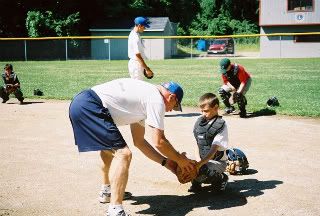LABall,
Here is how I instruct catchers to set up on the corners.
I have the catcher set up to give signs directly in the middle of the plate. Their sign giving stance has their feet no wider then their hips.
See the picture below to see a player your son's age in the sign giving stance we teach.

If he were to give a sign for a pitch away to a righty the only foot that moves is his right one. As he shifts he puts his weight on his left foot and steps to his right. When his right foot hits the ground he settles down into his crouch. At this time his middle is now in line with the right edge of the plate. If the pitcher hits that corner of the plate your catcher will be catching this strike directly in the middle of his body.
Obviously for a pitch in to a righty the right foot does not move and he steps with his left foot.
I am often asked at what age should a catcher begin to move to the corners and my answer is this, The catcher moves to that spot when the pitcher can consistently hit it. There is little to gain if a catcher moves outside and the young pitcher is so inaccurate that the catcher ends up diving to his left just to catch the errant throw.


